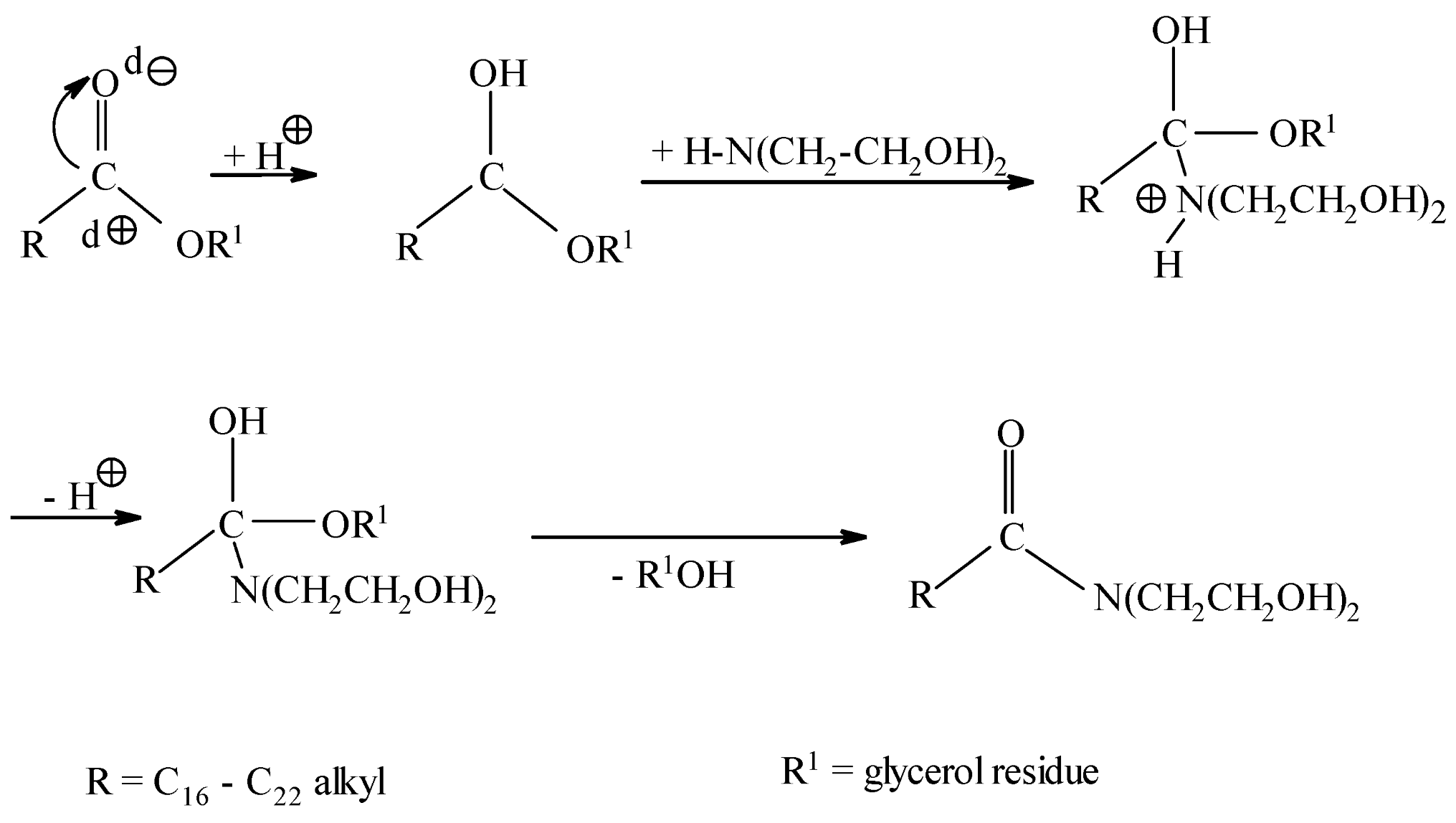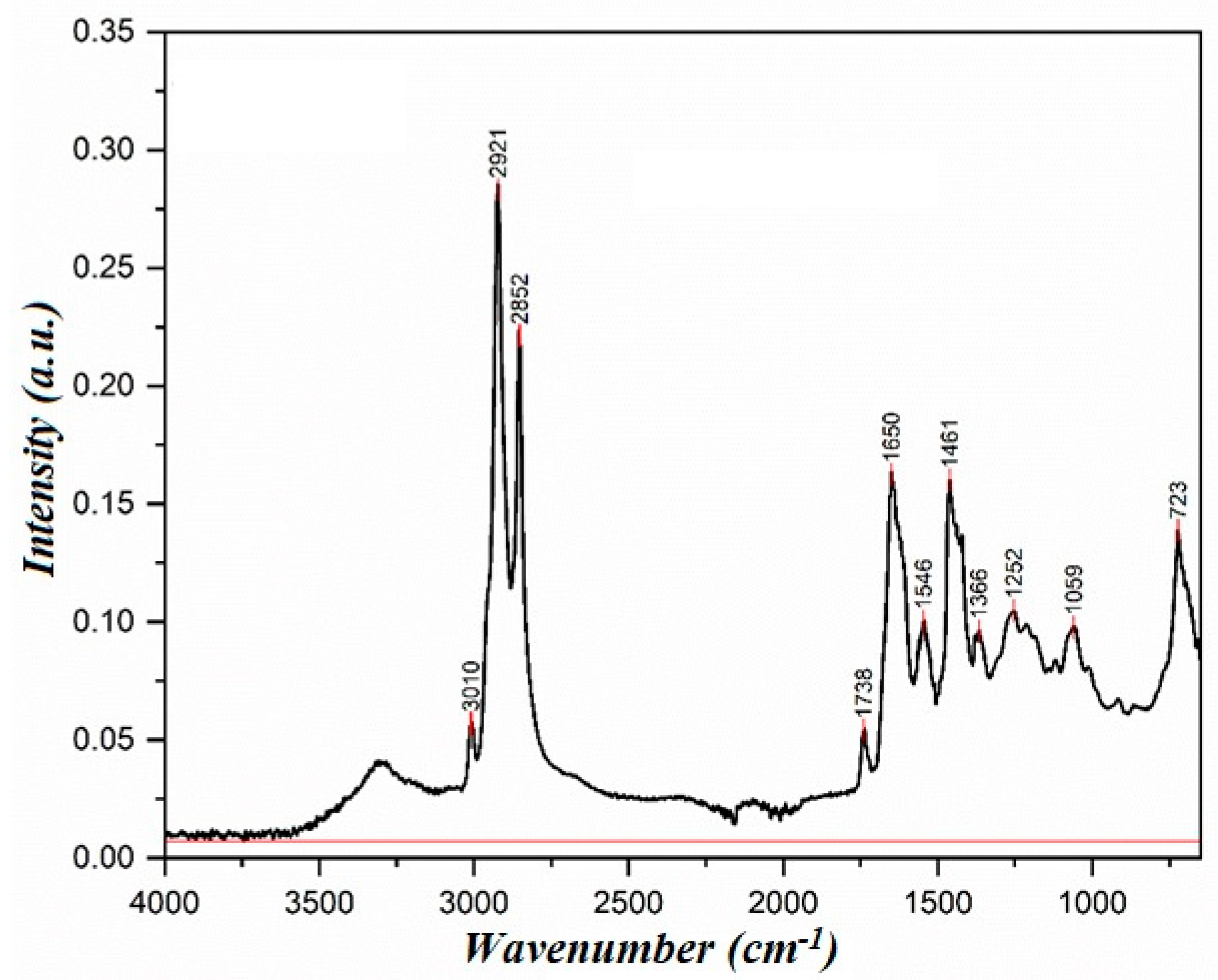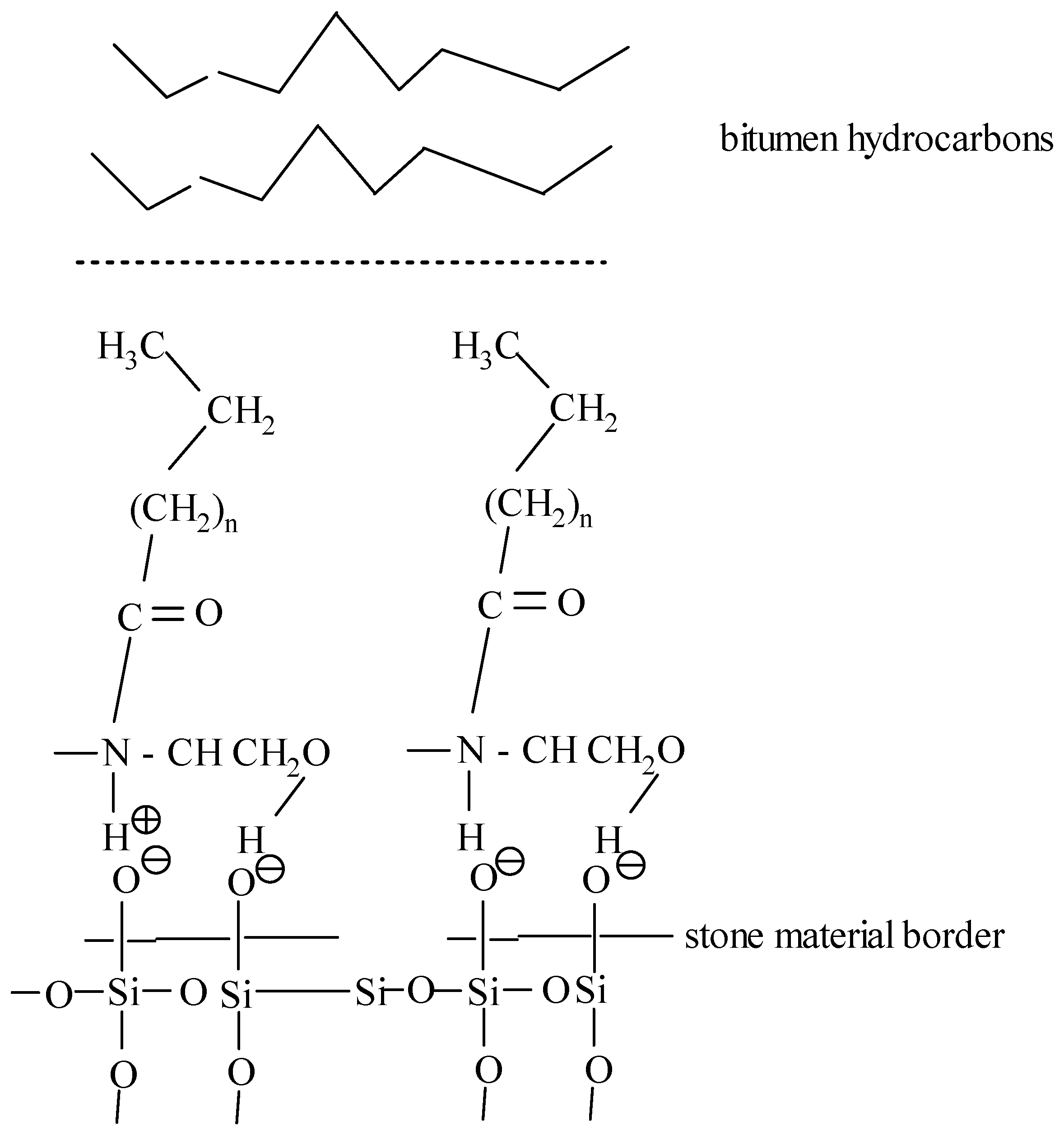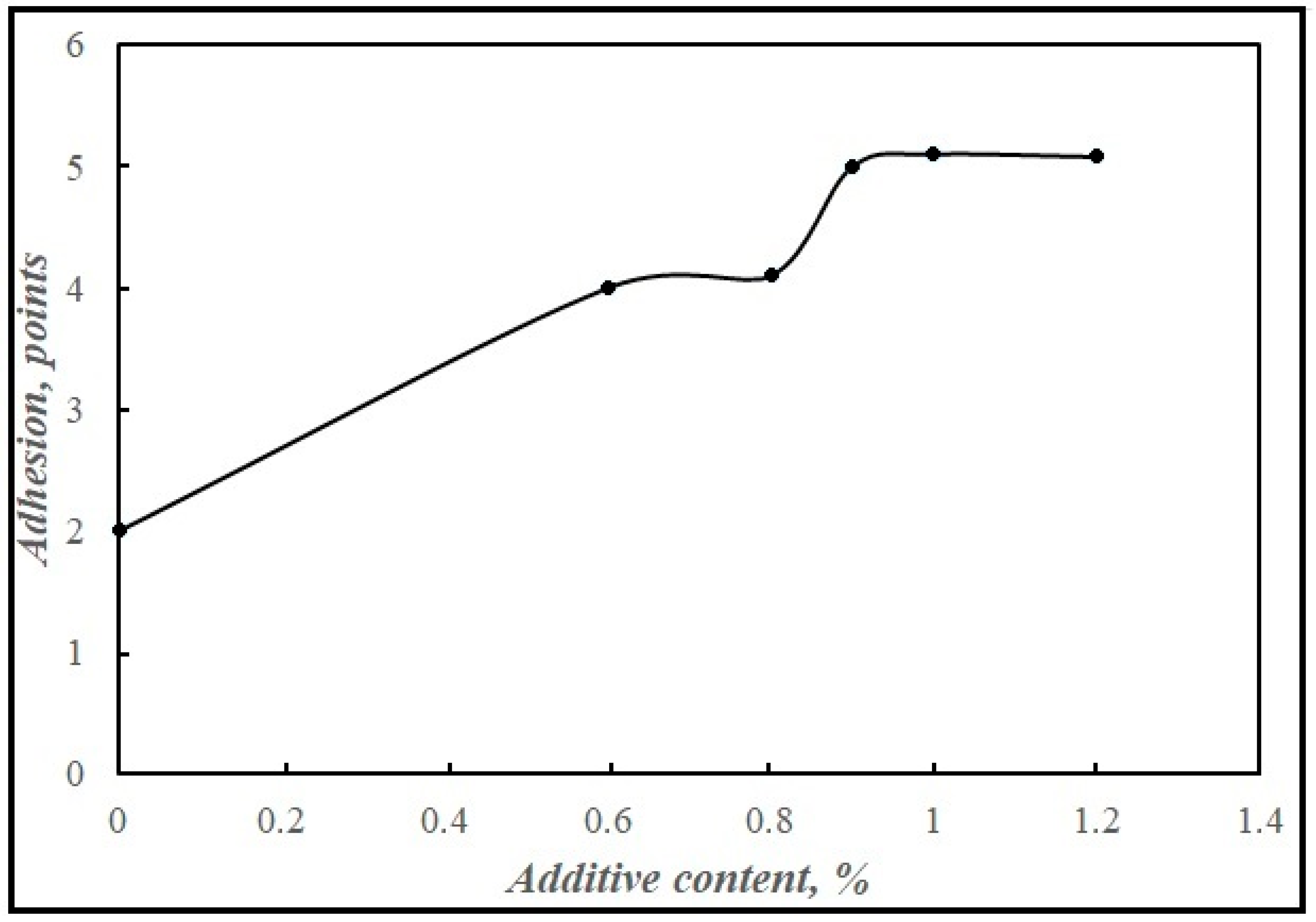Sustainable Adhesion Additive Improving Road Bitumen Properties with Rapeseed Oil Waste
Abstract
1. Introduction
2. Materials
2.1. Bitumen
2.2. Rock Material
2.3. Rapeseed Oil
2.4. Diethanolamine
3. Research Methods
Boiling Method
4. Results and Discussion
4.1. Synthesis of Adhesive Additive
- The interaction of higher carboxylic acids with diethanolamine.
- The interaction of triglycerides of higher carboxylic acids with diethanolamine.

4.2. Adhesion Quality Assessment
4.3. Rutting Resistance Tests
5. Conclusions
Author Contributions
Funding
Institutional Review Board Statement
Informed Consent Statement
Data Availability Statement
Conflicts of Interest
References
- Porto, M.; Caputo, P.; Loise, V.; Eskandarsefat, S.; Teltayev, B.; Oliviero Rossi, C. Bitumen and Bitumen Modification: A Review on Latest Advances. Appl. Sci. 2019, 9, 742. [Google Scholar] [CrossRef]
- Peden, R.A. Sustainability of bitumen use in highways. Proceedings of the Institution of Civil Engineers. Eng. Sustain. 2003, 156, 95–99. [Google Scholar] [CrossRef]
- Ingrassia, L.P.; Lu, X.; Ferrotti, G.; Canestrari, F. Chemical, morphological and rheological characterization of bitumen partially replaced with wood bio-oil: Towards more sustainable materials in road pavements. J. Traffic Transp. Eng. (Engl. Ed.) 2019, 7, 192–204. [Google Scholar] [CrossRef]
- Chauhan, S.K.; Shukla, A.; Gangopadhyay, S.; Sharma, S. Recent trends of the emission characteristics from the road construction industry. Environ. Sci. Pollut. Res. 2011, 19, 301. [Google Scholar] [CrossRef] [PubMed][Green Version]
- Teltayev, B. A new failure criterion for asphalt mixtures under fatigue loading. Int. J. Pavement Res. Technol. 2015, 8, 276–282. [Google Scholar] [CrossRef]
- Teltayev, B.; Radovskiy, B. Low temperature cracking problem for asphalt pavements in Kazakhstan. RILEM Bookseries 2016, 13, 139–144. [Google Scholar] [CrossRef]
- Petersen, J.C. Chapter 14 Chemical Composition of Asphalt as Related to Asphalt Durability. Asph. Asph. 2000, 2, 363–399. [Google Scholar] [CrossRef]
- Branthaver, J.F.; Petersen, J.C.; Robertson, R.E.; Duvall, J.J.; Kim, S.S.; Harnsberger, P.M. Aging Studies of Asphalt. In Binder Characterization and Evaluation; Vol. 2: Chemistry; Strategic Highway Research Program Report SHRP-A-368; National Research Council: Washington, DC, USA, 1993; pp. 189–285. [Google Scholar]
- Remišová, E.; Holý, M. Changes of Properties of Bitumen Binders by Additives Application. IOP Conf. Ser. Mater. Sci. Eng. 2017, 245, 032003. [Google Scholar] [CrossRef]
- Gawel, I.; Czechowski, F.; Kosno, J. An environmental friendly anti-ageing additive to bitumen. Constr. Build. Mater. 2016, 110, 42–47. [Google Scholar] [CrossRef]
- Shatnawi, S.R.; Van Kirk, J. Premature Asphalt Concrete Pavement Distress Caused by Moisture Induced Damage. In Transportation Research Record 1417; TRB, National Research Council: Washington, DC, USA, 1993; pp. 168–177. [Google Scholar]
- Ramaswamy, S. The effects of Amino antistrip additives on stripping of bituminous mixes. Highw. Transp. 1990, 37, 9–13. [Google Scholar]
- Lesueur, D. The colloidal structure of bitumen: Consequences on the rheology and on the mechanisms of bitumen modification. Adv. Colloid Interface Sci. 2009, 145, 42–82. [Google Scholar] [CrossRef]
- Liang, M.; Guo, M.; Tan, Y.; He, S.; Du, X. Evaluation of anti-ageing performance of bitumen based on rheological and chemical characterization. Int. J. Pavement Eng. 2023, 2213, 385. [Google Scholar] [CrossRef]
- Hung, A.M.; Mousavi, M.; Pahlavan, F.; Fini, E.H. Intermolecular Interactions of Isolated Bio-Oil Compounds and Their Effect on Bitumen Interfaces. ACS Sustain. Chem. Eng. 2017, 5, 7920–7931. [Google Scholar] [CrossRef]
- Werkovits, S.; Bacher, M.; Mirwald, L.; Theiner, L.; Rosenau, T.; Hofko, B.; Grothe, H. The impact of field ageing on molecular structure and chemistry of bitumen. Fuel 2023, 343, 127904. [Google Scholar] [CrossRef]
- Köfteci, S.; Ahmedzade, P.; Kultayev, B. Performance evaluation of bitumen modified by various types of waste plastics. Constr. Build. Mater. 2014, 73, 592–602. [Google Scholar] [CrossRef]
- Turobov, M.A.; Danilo, V.E.; Ayzenshtadt, A.M. Use of wood processing industry waste for bitumen modification. IOP Conf. Ser. Mater. Sci. Eng. 2020, 945, 012061. [Google Scholar] [CrossRef]
- Riccardi, C.; Losa, M. Recent advances and perspectives in circular bio-binder extender to substitute part of the fossil based binder in asphalt mixture. Constr. Build. Mater. 2024, 410, 134222. [Google Scholar] [CrossRef]
- Wong, T.L.X.; Hasan, M.R.M.; Peng, L.C. Recent development, utilization, treatment, and performance of solid wastes additives in asphaltic concrete worldwide: A review. J. Traffic Transp. Eng. (Engl. Ed.) 2022, 9, 693–724. [Google Scholar] [CrossRef]
- Wu, L.M.; Zhou, C.H.; Keeling, J.; Tong, D.S.; Yu, W.H. Towards an understanding of the role of clay minerals in crude oil formation, migration, and accumulation. Earth-Sci. Rev. 2012, 115, 373–386. [Google Scholar] [CrossRef]
- Billingham, J.; Breen, C.; Yarwood, J. In situ determination of Brønsted/Lewis acidity on cation-exchanged clay mineral surfaces by ATR-IR. Clay Miner. 1996, 31, 513–522. [Google Scholar] [CrossRef]
- Komadel, P.; Madejová, J. Chapter 7.1 Acid Activation of Clay Minerals. Handb. Clay Sci. 2006, 1, 263–287. [Google Scholar] [CrossRef]
- Djomgoue, P.; Njopwouo, D. FT-IR Spectroscopy Applied for Surface Clays Characterization. J. Surf. Eng. Mater. Adv. Technol. 2013, 3, 275–282. [Google Scholar] [CrossRef]
- GOST 5985-59; Petroleum Products. Method for Determining Acidity and Acid Number (Nefteprodukty. Metod opredeleniya kislotnosti i kislotnogo chisla). Available online: https://www.russiangost.com/p-251162-gost-5985-59.aspx (accessed on 11 December 2024). (In Russian).
- National Standard of Republic Kazakhstan 1225-2013; Asphalt Concrete Road, Airport and Asphalt Concrete Mixtures (Smesi asfal’tobetonnye dorozhnye, aerodromnye i asfal’tobeton). Committee for Technical Regulation and Metrology: Astana, Kazakhstan, 2013. (In Russian)
- ASTM D3625/D3625M-12; Standard Practice for Effect of Water on Bituminous-Coated Aggregate Using Boiling Water. ASTM International: West Conshohocken, PA, USA, 2012.
- ASTM D1664-80; Standard Test Method for Coating and Stripping of Bitumen-Aggregate Mixtures. ASTM International: West Conshohocken, PA, USA, 1980.
- AASHTO T 182-84; Standard Method of Test for Coating and Stripping of Bitumen-Aggregate Mixtures. American Association of State Highway and Transportation Officials: Washington, DC, USA, 1984.
- Sykes, P. A Guidebook to Mechanism in Organic Chemistry, 6th ed.; Crist’s College: Cambridge, UK, 1991; 417p. [Google Scholar]
- Saal, R.N.J.; Labout, J.W.A. The Relation Between Absolute Viscosity and Penetration of Asphaltic Bitumens. Physics 1936, 7, 408–412. [Google Scholar] [CrossRef]
- Sihombing, A.V.R.; Utami, R.; Somantri, A.K.; Febriansya, A.; Sihombing, R.P.; Mulyadi, A.M. Stone Matrix Asphalt Performance with Glycerin Pitch as Asphalt Binder Extender. Period. Polytech. Civ. Eng. 2023, 67, 582–595. [Google Scholar] [CrossRef]
- Ahmed, R.B.; Hossain, K.; Hajj, R.M. Chemical, Morphological, and Fundamental Properties of Rejuvenated Asphalt Binders. J. Mater. Civ. Eng. 2020, 33, 04020461. [Google Scholar] [CrossRef]
- Cheng, Y.; Zhang, X.; Dong, Y.; Chen, J. Preparation and Road Performance of Solvent-Based Cold Patch Asphalt Mixture. Int. J. Pavement Res. Technol. 2022, 15, 1155–1165. [Google Scholar] [CrossRef]
- Haghshenas, H.F.; Rea, R.; Gerald Reinke, G.; Yousefi, A.; Haghshenas, D.F.; Pooyan Ayar, P. Effect of Recycling Agents on the Resistance of Asphalt Binders to Cracking and Moisture Damage. J. Mater. Civ. Eng. Arch. 2021, 33, 04021292. [Google Scholar] [CrossRef]
- Osman, H.; Hasan, M.R.M.; Mukhtar, N.; Ghazali, M.F.H.M.; Raman, N.A.A. Effects of Alkylamines-Based and Polyalkylene Glycol-Based Bonding Enhancers on the Performance of Asphalt Binders. IOP Conf. Ser. Earth Environ. Sci. 2021, 920, 012021. [Google Scholar] [CrossRef]
- Levin, J.O.; Andersson, K.; Hallgren, C. Exposure to low molecular polyamines during road paving. Ann. Occup. Hyg. 1994, 38, 257–264. [Google Scholar] [CrossRef]
- Syroezhko, A.M.; Baranov, M.A.; Ivanov, S.N.; Maidanova, N.V. Influence of natural additives and those synthesized by the Fischer-Tropsch method on the properties of petroleum bitumen and quality of floated asphalt. Coke Chem. 2011, 54, 26–31. [Google Scholar] [CrossRef]
- Oliviero Rossi, C.; Teltayev, B.; Angelico, R. Adhesion Promoters in Bituminous Road Materials: A Review. Appl. Sci. 2017, 7, 524. [Google Scholar] [CrossRef]
- ST RK EN 12697-22-2012; Standard Test Methods for Asphalt Concrete Road, Airport, and Asphalt Mixtures (Metody ispytanii na asfaltobetonnykh smesey dorozhnykh, aerodromnykh i asfal’tobeton). Committee for Technical Regulation and Metrology: Astana, Kazakhstan, 2012. (In Russian)
- EN 12697-22; Standard Test Method for Wheel Tracking Test of Bituminous Mixtures. European Committee for Standardization (CEN): Brussels, Belgium, 2003.











| Name | % |
|---|---|
| SiO2—quartz | 57.1 |
| Na(AlSi3O8)—albite 1/2Na2O × 1/2 Al2O3 × 3SiO2 | 28.1 |
| CaCO3—limestone | 9.1 |
| Mg4.882Fe0.22Al1.881Si2.96O10(OH)8 clinochlore 2.882MgO × 2Mg(OH)2 × 0.11Fe2O3 × 1.881Al2O3 × 2.96SiO2 | 5.1 |
Disclaimer/Publisher’s Note: The statements, opinions and data contained in all publications are solely those of the individual author(s) and contributor(s) and not of MDPI and/or the editor(s). MDPI and/or the editor(s) disclaim responsibility for any injury to people or property resulting from any ideas, methods, instructions or products referred to in the content. |
© 2025 by the authors. Licensee MDPI, Basel, Switzerland. This article is an open access article distributed under the terms and conditions of the Creative Commons Attribution (CC BY) license (https://creativecommons.org/licenses/by/4.0/).
Share and Cite
Nadirov, R.; Ketegenov, T.; Batkal, A.; Kalugin, S.; Teltayev, B.; Caputo, P.; Oliviero Rossi, C.; Kamunur, K.; Assylkhanov, Z.; Osserov, T. Sustainable Adhesion Additive Improving Road Bitumen Properties with Rapeseed Oil Waste. Sustainability 2025, 17, 1472. https://doi.org/10.3390/su17041472
Nadirov R, Ketegenov T, Batkal A, Kalugin S, Teltayev B, Caputo P, Oliviero Rossi C, Kamunur K, Assylkhanov Z, Osserov T. Sustainable Adhesion Additive Improving Road Bitumen Properties with Rapeseed Oil Waste. Sustainability. 2025; 17(4):1472. https://doi.org/10.3390/su17041472
Chicago/Turabian StyleNadirov, Rashid, Tlek Ketegenov, Aisulu Batkal, Sergey Kalugin, Bagdat Teltayev, Paolino Caputo, Cesare Oliviero Rossi, Kaster Kamunur, Zhanibek Assylkhanov, and Timur Osserov. 2025. "Sustainable Adhesion Additive Improving Road Bitumen Properties with Rapeseed Oil Waste" Sustainability 17, no. 4: 1472. https://doi.org/10.3390/su17041472
APA StyleNadirov, R., Ketegenov, T., Batkal, A., Kalugin, S., Teltayev, B., Caputo, P., Oliviero Rossi, C., Kamunur, K., Assylkhanov, Z., & Osserov, T. (2025). Sustainable Adhesion Additive Improving Road Bitumen Properties with Rapeseed Oil Waste. Sustainability, 17(4), 1472. https://doi.org/10.3390/su17041472












